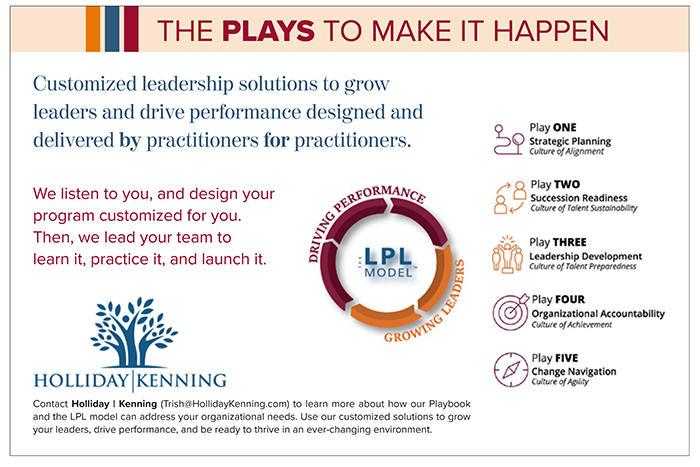Learn it. Practice It. Launch It.
By “Doc” Holliday
One of the foremost authorities on the informal organization, Jon Katzenbach, suggested that organizations can begin to shape their culture with 5 key behaviors.
- Find a Theme
- Don’t claim victory too soon.
- Enlist the help of informal leaders.
- Remember that cultural forces don’t go away.
- Start now.
For one reason or another, it’s that fifth behavior that proves to be the most elusive for most organizations.
Alfred North Whitehead was an early 20th century English mathematician and philosopher. Best known as the father of Process Philosophy, Whitehead once said, “Ideas won’t keep. Something must be done about them.”
Understanding organizational success and culture is important when leading for impact. Culture is comprised of tangible and intangible aspects and includes patterns of behavior and expectations for behavior that are often deeply ingrained in the organizational fabric. People at all levels of an organization influence and are influenced by culture. Therefore, a need exists for intentional cultural transformation. What if there was a way of driving performance while also growing leaders?
The Holliday | Kenning Playbook is a framework for organizational success that drives cultural transformation using the unique LPL (Learn It, Practice It, Launch It) model. It is a three-step process to:
· Explore ways to create a learning culture
· Develop habits for success
· Turn plans into action with an executable strategy
Each step in the process addresses one of the major challenges of bringing ideas to fruition and provides the knowledge and tools to avoid failure. These principles ring true whether an individual is trying to make a small personal change, or an organization is attempting a mission shift. Learn It, Practice It, and Launch It are the keys to making it happen.
LEARN IT
The ancient wisdom that learning never ends is of great modern importance. Company leaders have embraced the importance of adaptability to thriving in today’s quick-changing business environment. Furthermore, employees from the next generation expect a workplace that will continually feed their minds and build their skills. Studies agree that training and development opportunities are some of the most popular benefits an employer can offer to Millennials.
When we think about organizations that have transformed into high performing organizations, we recognize there is one thing in common in all of them – learning was integrated into the fabric of the culture of the organization. This is a say easy do hard concept and one reason why the LPL model can help to transform how an organization does business.
Carol Dweck’s work on Growth mindsets and Fixed mindsets highlights the importance of learning as a core component to the culture of an organization. According to Dweck, “a ‘growth mindset’ thrives on challenge and sees failure not as evidence of unintelligence but as a heartening springboard for growth and for stretching our existing abilities.” With this attitude, learning is not an event or an activity, it is entrenched in the environment.
The Learn It part of the LPL model emphasizes the importance of integrating learning into the culture of the business. High-performing learning organizations provide tailored learning that factor in backgrounds, life experiences, and career goals ensuring each member of the workforce’s learning pathway helps them accomplish their career goals.
Learn It positions learning as a significant value to the success of a high performing organization. The LPL Model begins with Learn It because that is how transformation begins. We must first learn what we need to know in order to drive change and improve efficiencies and effectiveness which necessitates creating work cultures that are geared toward constant learning. Creating and maintaining a true learning culture requires continuous measurement, the disciplined use of processes, the ability to overcome objections while integrating the concept of learning into how the organization operates.
PRACTICE IT
This gap between intellectual understanding and skill development can be bridged by only one thing – practice. Sometimes a lot of it. In the book, Outliers, Malcom Gladwell suggests that it takes 10,000 hours of practice to become an expert at something. Wow! That’s 1,250 workdays or 250 weeks. Over 5 years. In his book The Personal MBA, Josh Kaufman, asserts that it takes about 20 hours of practice to go from “knowing nothing to being pretty good.” Splitting the difference, to be somewhere between “pretty good” and “expert” at something, somewhere between 20 and 10,000 hours of practice is needed.
Yet, many are resistant to the idea of practice. Often, we have the intellectual capacity to understand what needs to be done and we naively believe this understanding give us the ability to do it. The reality is competence comes from practicing, getting feedback, adapting, and then practicing again. So why do we not practice it? It takes time and it requires us to be vulnerable. When we try something new and it’s awkward or we feel clumsy, it can be easier to revert to the familiar. It may not be the optimal solution, but it’s the one that makes us feel comfortable.
Practice not only gives us the opportunity to develop and refine a skill, practice serves another essential purpose – it transforms that behavior into a habit and habits are incredibly potent forces. As you practice a skill, you rewire a part of your brain called the basil ganglia. Our brains are continually looking for ways to conserve mental energy and automate our decision-making processes. Habits are the way in which they accomplish this. The practiced skill becomes automatic. That’s why bad habits are so hard to break, and good habits are so powerful.
Former NFL quarterback Peyton Manning said it best when he stated, “I never left the field saying I could have done more to get ready and that gives me piece of mind.” Practice transfers the skill into an action that can be done competently and automatically – a habit.
LAUNCH IT
The LAUNCH IT part of the LPL model is the final component to creating cultural transformation. It is important to know the core reasons that transformation fails in order to avoid the pitfalls that keep success from happening. Common pitfalls are:
· Lack of leadership buy-in and ownership
· The level of resistance to change within the organization
· The change is not anchored in the organizational structure
· There is poor technical planning
· There is complacency among the workforce
· Failure to create short term goals along with the long-term goals
· Lack of communication throughout the organization
· Lack of trust in leadership
Think about what it takes to launch something, whether it is a new business, a new idea, a new program, a new product, or a new service. We must understand the environment and the landscape in which we are about to launch. Once the landscape has been surveyed though, it’s time. Alfred Whitehead was right. An idea is great, but the idea has no value unless it is put into action.
If your organization (any size) desires a culture of achievement, a culture of agility, a culture of alignment, a culture of talent sustainability, or a culture of talent preparedness then implementing the LPL model will help you reach optimal performance. The LPL model provides the approaches needed to take strategy to action, the identification of emerging leaders to the next level, succession planning to a full bench of future leaders, metrics to impact, and change to transformation.
The HK Playbook offers customized solutions designed to grow leaders and thrive in an ever-changing environment. Whether it is one area or multiple, the tailored plays within the framework accelerate organizational success. Be sure to explore our website for more insights and contact information.

Dr. Trish Holliday, SPHR, SHRM-SCP, IPMA-SCP, CPC
Founding Partner, Holliday | Kenning
trish@hollidaykenning.com
www.hollidaykenning.com

Lucinda Kenning, MBA
Founding Partner, Holliday | Kenning
lucinda@hollidaykenning.com
www.hollidaykenning.com

